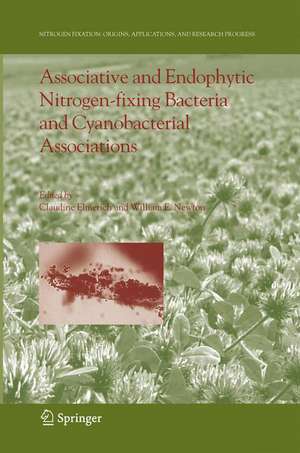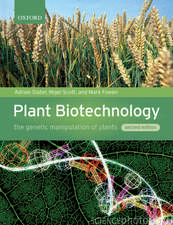Associative and Endophytic Nitrogen-fixing Bacteria and Cyanobacterial Associations: Nitrogen Fixation: Origins, Applications, and Research Progress, cartea 5
Editat de Claudine Elmerich, William E. Newtonen Limba Engleză Hardback – 24 oct 2006
| Toate formatele și edițiile | Preț | Express |
|---|---|---|
| Paperback (1) | 790.60 lei 39-44 zile | |
| SPRINGER NETHERLANDS – 30 noi 2010 | 790.60 lei 39-44 zile | |
| Hardback (1) | 955.88 lei 6-8 săpt. | |
| SPRINGER NETHERLANDS – 24 oct 2006 | 955.88 lei 6-8 săpt. |
Preț: 955.88 lei
Preț vechi: 1165.70 lei
-18% Nou
Puncte Express: 1434
Preț estimativ în valută:
182.91€ • 188.70$ • 152.64£
182.91€ • 188.70$ • 152.64£
Carte tipărită la comandă
Livrare economică 27 martie-10 aprilie
Preluare comenzi: 021 569.72.76
Specificații
ISBN-13: 9781402035418
ISBN-10: 1402035411
Pagini: 348
Ilustrații: XXI, 323 p.
Dimensiuni: 155 x 235 x 27 mm
Greutate: 0.74 kg
Ediția:2007
Editura: SPRINGER NETHERLANDS
Colecția Springer
Seria Nitrogen Fixation: Origins, Applications, and Research Progress
Locul publicării:Dordrecht, Netherlands
ISBN-10: 1402035411
Pagini: 348
Ilustrații: XXI, 323 p.
Dimensiuni: 155 x 235 x 27 mm
Greutate: 0.74 kg
Ediția:2007
Editura: SPRINGER NETHERLANDS
Colecția Springer
Seria Nitrogen Fixation: Origins, Applications, and Research Progress
Locul publicării:Dordrecht, Netherlands
Public țintă
ResearchCuprins
Preface to the Series. Preface. List of Contributors. Dedication.
1. Historical Perspective: From Bacterization to Endophytes; C. Elmerich
1. The Nitrogen Cycle: Heritage from the 19th Century
2. Nutritional Interactions between Bacteria and Plants
3. Associative Nitrogen-fixing Bacteria
4. Discovery of Nitrogen-fixing Endophytes
5. Cyanobacterial Associations
6. Concluding Remarks
Acknowledgement
References
2. Molecular Phylogeny and Ecology of Root-Associated Diazotrophic a- and ß-Protobacteria; M. Schmid and A. Hartmann
1. Introduction
2. Tools for Molecular Phylogeny and in situ Localizationof Bacterial Isolates and Communities
3. Molecular Phylogeny and Ecology of Azospirillum and Other Nitrogen-fixing a-Subclass Protobacteria
4. Molecular Phylogeny and Ecology of Herbaspirillum, Diazotrophic Burkholderia spp., and Other Nitrogen-fixing ß-Protobacteria
5. Conclusions and Prospects for Future Studies
Acknowledgements
References
3. Regulation of Nitrogen Fixation and Ammonium Assimilation in Associative and Endophytic Nitrogen-fixing Bacteria; F. O. Pedrosa and C. Elmerich
1. Introduction
2. Rhizospheric and Endophytic Bacteria: General Features
3. Structural Organization of nif Genes
4. Identification of RpoN and Its Involvement in Nitrogen Fixation
5. Thr Ntr System and Control of Nitrogen Metabolism and Nitrogen Fixation
6. Regulation of Nitrogen Fixation
7. Conclusions
Acknowledgements
References
4. Chemotaxis in Soil Diazotrophs: Survival and Adaptive Response; G. Alexandre and I. B. Zhulin
1. Introduction
2. Gene-Expression Regulation and Chemotaxis as Adaptive Responses to Environmental changes
3. Molecular Mechanism of the Chemotactic Response: Learning from Escherichia coli
4. Directed Motility in Soil Diazotrophs
5.Future Studies
References
5. Molecular Genetics of Rhizosphere and Plant-Root Colonization; E. Vanbleu and J. Vanderleyden
1. Introduction
2. Motility of Associative Diazotrophs
3. Attachment to Plant Roots
4. Rhizosphere Competence
5. Conclusions
Acknowledgement
References
6. Microbial Production of Plant Hormones; B. E. Baca and C. Elmerich
1. Discovery of Phytohormones
2. Production and Role of Phytohormones
3. Pathways for Plant Hormone Biosynthesis: Common Routes in Plants, Bacteria and Fungi
4. Major Routes for IAA synthesis in Pathogenic and Beneficial Nitrogen-fixing Bacteria Associated with Plants
5. Multiple Routes for IAA Synthesis in Azospirillum
6. Other Phytohormones Produced by Plant Pathogenic and Nitrogen-fixing Associated and Endophytic Bacteria
7. Plant Growth Promotion (PGP): Role of Bacterial Phytohormone Production, ACC-Deaminase, and the Use of Synthetic Auxins
8. Concluding Remarks
Acknowledgement
References
7. The Plant Growth-Promoting Effect and Plant Responses; S. Dobbelaere and Y. Okon
1. N2 Fixation vs. "Hormonal" Effects: Historical Perspectives
2. Effects of Azospirillum and Other Diazotrophs on Root Morphology
3. Effects on Root Function
4. Effects on Plant Growth
5. Future Studies
References
8. Biocontrol of Plant Diseases by Associative and Endophytic Nitrogen-fixing Bacteria; R. Bally and C. Elmerich
1. Beneficial Plant-Associated Nitrogen-fixing Bacteria and Biocontrol of Plant Disease
2. Interactions within Microbial Communities: Competition
3. Biological Control against Soil-Borne Diseases
4. Regulation of Biocontrol Properties and Cell-Cell
5. Plant Response to Pathogens and Biological Control in the Rhizosphere
6. Concluding Remarks
Acknowledgements
References
9. Endophytic Associations of Azoarcus spp; B. Reinhold-Hurek and T. Hurek
1. Introduction
2. The Rise of Interest in Diazotrophic Endophytes
3. Azoarcus spp. and related Genera: Strictly Plant-Associated vs. Soil Bacteria
4. Habitats and Ecophysiology
5. Interactions with Fungi
6. Infection of Roots by Endophytic Diazotrophs: An Active Specific Process?
7. Concluding Remarks
References
10. Biological Nitrogen Fixation in Sugarcane; V. Reis, S. Lee and C. Kennedy
1. Short History of the Sugarcane-Cropping System
2. Nitrogen-fixing Bacteria Colonizing Sugarcane: New Phylogenetic Data, Properties, and Endophytic Status
3. Contribution of BNF to the Sugarcane Crop
4. Effect of N Fertilization on BNF
5. Genes for Nitrogen Fixation and Their Regulation in G. diazotrophicus and H. seropedicae
6. Is Indole Acetic Acid Production an Important Factor in the Ability of G. diazotrophicus to Enhance Growth of Sugarcane?
7. Concluding Remarks
Acknowledgements
References
11. Heterocyst Differentiation and Nitrogen Fixation in Cyanobacteria; R. Haselkorn
1. Early History of the Association of Nitrogen Fixation with Heterocysts
2. Cyanobacterial Nitrogenase and nif-Genes Organization
3. Pathway of N Assimilation
4. Carbon Metabolism in Heterocysts
5. Genetic Tools for Studying Cyanobacterial Nitrogen Fixation
6. Regulatory Genes Required for Heterocyst Differentiation
7. Prospects
Acknowledgement
References
12. Cyanobacterial Associations; B. Bergman, A. N. Rai and U. Rasmussen
1. Introduction
2. Historical Aspects and Landmarks
3. Symbioses with Diatoms (Algae)
4. Symbioses with Fungi
5. Symbioses with Bryophytes
6. Symbioses with Pteridophytes
7. Symbioses with Cycads
8. Symbiosis with Gunnera
9. Creation of New Symbioses and Prospects
Acknowledgements
References
13. Prospects for Significant Nitrogen Fixation in Grasses from Bacterial Endophytes; E. W. Triplett
1. Ultimate Objective of Nitrogen-fixation Research – Nitrogen Fixation in Maize, Wheat and Rice
2. Understanding the Basic Biology of Endophytic Colonization: Using K. pneumoniae 342 as the Model Diazotrophic Endophyute
3. Attributes Needed for a Model Diazotrophic Endophyte
4. Future Work Needed to Replace Nitrogen Fertilizer with Diazotrophic Endophytes
References
Subject Index
1. Historical Perspective: From Bacterization to Endophytes; C. Elmerich
1. The Nitrogen Cycle: Heritage from the 19th Century
2. Nutritional Interactions between Bacteria and Plants
3. Associative Nitrogen-fixing Bacteria
4. Discovery of Nitrogen-fixing Endophytes
5. Cyanobacterial Associations
6. Concluding Remarks
Acknowledgement
References
2. Molecular Phylogeny and Ecology of Root-Associated Diazotrophic a- and ß-Protobacteria; M. Schmid and A. Hartmann
1. Introduction
2. Tools for Molecular Phylogeny and in situ Localizationof Bacterial Isolates and Communities
3. Molecular Phylogeny and Ecology of Azospirillum and Other Nitrogen-fixing a-Subclass Protobacteria
4. Molecular Phylogeny and Ecology of Herbaspirillum, Diazotrophic Burkholderia spp., and Other Nitrogen-fixing ß-Protobacteria
5. Conclusions and Prospects for Future Studies
Acknowledgements
References
3. Regulation of Nitrogen Fixation and Ammonium Assimilation in Associative and Endophytic Nitrogen-fixing Bacteria; F. O. Pedrosa and C. Elmerich
1. Introduction
2. Rhizospheric and Endophytic Bacteria: General Features
3. Structural Organization of nif Genes
4. Identification of RpoN and Its Involvement in Nitrogen Fixation
5. Thr Ntr System and Control of Nitrogen Metabolism and Nitrogen Fixation
6. Regulation of Nitrogen Fixation
7. Conclusions
Acknowledgements
References
4. Chemotaxis in Soil Diazotrophs: Survival and Adaptive Response; G. Alexandre and I. B. Zhulin
1. Introduction
2. Gene-Expression Regulation and Chemotaxis as Adaptive Responses to Environmental changes
3. Molecular Mechanism of the Chemotactic Response: Learning from Escherichia coli
4. Directed Motility in Soil Diazotrophs
5.Future Studies
References
5. Molecular Genetics of Rhizosphere and Plant-Root Colonization; E. Vanbleu and J. Vanderleyden
1. Introduction
2. Motility of Associative Diazotrophs
3. Attachment to Plant Roots
4. Rhizosphere Competence
5. Conclusions
Acknowledgement
References
6. Microbial Production of Plant Hormones; B. E. Baca and C. Elmerich
1. Discovery of Phytohormones
2. Production and Role of Phytohormones
3. Pathways for Plant Hormone Biosynthesis: Common Routes in Plants, Bacteria and Fungi
4. Major Routes for IAA synthesis in Pathogenic and Beneficial Nitrogen-fixing Bacteria Associated with Plants
5. Multiple Routes for IAA Synthesis in Azospirillum
6. Other Phytohormones Produced by Plant Pathogenic and Nitrogen-fixing Associated and Endophytic Bacteria
7. Plant Growth Promotion (PGP): Role of Bacterial Phytohormone Production, ACC-Deaminase, and the Use of Synthetic Auxins
8. Concluding Remarks
Acknowledgement
References
7. The Plant Growth-Promoting Effect and Plant Responses; S. Dobbelaere and Y. Okon
1. N2 Fixation vs. "Hormonal" Effects: Historical Perspectives
2. Effects of Azospirillum and Other Diazotrophs on Root Morphology
3. Effects on Root Function
4. Effects on Plant Growth
5. Future Studies
References
8. Biocontrol of Plant Diseases by Associative and Endophytic Nitrogen-fixing Bacteria; R. Bally and C. Elmerich
1. Beneficial Plant-Associated Nitrogen-fixing Bacteria and Biocontrol of Plant Disease
2. Interactions within Microbial Communities: Competition
3. Biological Control against Soil-Borne Diseases
4. Regulation of Biocontrol Properties and Cell-Cell
5. Plant Response to Pathogens and Biological Control in the Rhizosphere
6. Concluding Remarks
Acknowledgements
References
9. Endophytic Associations of Azoarcus spp; B. Reinhold-Hurek and T. Hurek
1. Introduction
2. The Rise of Interest in Diazotrophic Endophytes
3. Azoarcus spp. and related Genera: Strictly Plant-Associated vs. Soil Bacteria
4. Habitats and Ecophysiology
5. Interactions with Fungi
6. Infection of Roots by Endophytic Diazotrophs: An Active Specific Process?
7. Concluding Remarks
References
10. Biological Nitrogen Fixation in Sugarcane; V. Reis, S. Lee and C. Kennedy
1. Short History of the Sugarcane-Cropping System
2. Nitrogen-fixing Bacteria Colonizing Sugarcane: New Phylogenetic Data, Properties, and Endophytic Status
3. Contribution of BNF to the Sugarcane Crop
4. Effect of N Fertilization on BNF
5. Genes for Nitrogen Fixation and Their Regulation in G. diazotrophicus and H. seropedicae
6. Is Indole Acetic Acid Production an Important Factor in the Ability of G. diazotrophicus to Enhance Growth of Sugarcane?
7. Concluding Remarks
Acknowledgements
References
11. Heterocyst Differentiation and Nitrogen Fixation in Cyanobacteria; R. Haselkorn
1. Early History of the Association of Nitrogen Fixation with Heterocysts
2. Cyanobacterial Nitrogenase and nif-Genes Organization
3. Pathway of N Assimilation
4. Carbon Metabolism in Heterocysts
5. Genetic Tools for Studying Cyanobacterial Nitrogen Fixation
6. Regulatory Genes Required for Heterocyst Differentiation
7. Prospects
Acknowledgement
References
12. Cyanobacterial Associations; B. Bergman, A. N. Rai and U. Rasmussen
1. Introduction
2. Historical Aspects and Landmarks
3. Symbioses with Diatoms (Algae)
4. Symbioses with Fungi
5. Symbioses with Bryophytes
6. Symbioses with Pteridophytes
7. Symbioses with Cycads
8. Symbiosis with Gunnera
9. Creation of New Symbioses and Prospects
Acknowledgements
References
13. Prospects for Significant Nitrogen Fixation in Grasses from Bacterial Endophytes; E. W. Triplett
1. Ultimate Objective of Nitrogen-fixation Research – Nitrogen Fixation in Maize, Wheat and Rice
2. Understanding the Basic Biology of Endophytic Colonization: Using K. pneumoniae 342 as the Model Diazotrophic Endophyute
3. Attributes Needed for a Model Diazotrophic Endophyte
4. Future Work Needed to Replace Nitrogen Fertilizer with Diazotrophic Endophytes
References
Subject Index
Caracteristici
Addresses associations less formalized than the rhizobia-legume associations but have a myriad of effects on their plant hosts Provides up-to-date and in-depth coverage of molecular phylogeny, root colonization, how nitrogen fixation and ammonia assimilation are regulated, phytohormone production, disease biocontrol, plant growth promotion, N2-fixing endophytic associations with rice and sugarcane, heterocyst differentiation and cyanobacterial associations

















